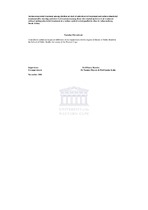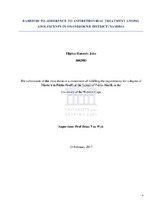| dc.contributor.advisor | Hausler, Harry | |
| dc.contributor.advisor | Meyers, Tammy | |
| dc.contributor.advisor | Kuhn, Louise | |
| dc.contributor.author | Chivonivoni, Tamuka | |
| dc.contributor.other | School of Public Health | |
| dc.contributor.other | Faculty of Science | |
| dc.date.accessioned | 2013-06-21T12:07:10Z | |
| dc.date.available | 2013/02/15 13:58 | |
| dc.date.available | 2013/02/15 | |
| dc.date.available | 2013-06-21T12:07:10Z | |
| dc.date.issued | 2010 | |
| dc.identifier.uri | http://hdl.handle.net/11394/1562 | |
| dc.description | Magister Public Health - MPH | en_US |
| dc.description.abstract | Background: Although clinicians encounter antimycobacterial treatment in Human mmunodeficiency (HIV)-infected children as one of the most common treatments coadministered with antiretroviral treatment (ART), quantitative data on the extent of antimycobacterial treatment among HIV-infected children at the time of commencement of ART and at different times during ART is scarce. The baseline risk factors associated with being on both ART and antimycobacterial treatments are not known and it remains to be elucidated how the different exposure factors impact on the antimycobacterial treatment-free survival of children who begin ART without antimycobacterial treatment.Objectives: To describe the prevalence of antimycobacterial treatment among children at the time of starting ART and the antimycobacterial treatment-free survival after starting ART. Design: A retrospective cohort study based on record reviews at the Harriet Shezi children‘s clinic (HSCC).Population: HIV-infected children less than fifteen years of age presumed ART naïve started on ART at HSCC.Analysis: A descriptive analysis of the prevalence of antimycobacterial treatment at time of start of ART was done. Kaplan Meier (KM) survival curves were used to determine the antimycobacterial treatment-free survival and logistic regression was used to analyze the association between baseline factors and future antimycobacterial treatment among children who had no antimycobacterial treatment at time of start of ART. Results: The prevalence of antimycobacterial treatment at the time of starting ART was 518/1941 (26.7%, 95% confidence interval (CI): 24.7-28.7). Among children who started ART without antimycobacterial treatment, the KM cumulative probability of antiretroviral and antimycobacterial (ART/antimycobacterial) co-treatment in the first 3 months of starting ART was 4.6% (95% CI: 4.1- 5.2), in the first 12 months it was 18.1% (95% CI: 17.0-19.2) and in the first 24 months of starting ART it was 24% (95% CI: 21.9-25.1). Survival analysis suggested that children with high baseline viral load, advanced World Health Organization (WHO) stage of disease, very low normalized weight for age (waz) and very young age (less than one year) at start of ART had significantly reduced antimycobacterial treatment-free survival (log rank p < 0.05) in the first two years of starting ART. In the logistic regression model, age less than one year {Odds ratio (OR): 3.7 (95% CI: 2.2-6.0; p <0.0001)} and very low weight for age Z-score (waz < -3) {OR; 2.2 (95% CI: 1.4-3.6; p = 0.0015)} were the two critical risk factors independently associated with future antimycobacterial treatment. Conclusions: Antimycobacterial treatment is extremely common among HIV-infected children at the time of starting ART and early after starting ART and the incremental risk of being on ART/antimycobacterial co-treatment decreases with time on ART. The results emphasize the need for a heightened and careful alertness for mycobacterial events especially among children starting ART with severe malnutrition and those who start ART at age less than one year. The results further suggest that it is probably optimal to start ART in children before their nutritional status has deteriorated severely in the course of the HIV disease so that they get protection against mycobacterial events by early ART. | en_US |
| dc.language.iso | en | en_US |
| dc.publisher | University of the Western Cape | en_US |
| dc.subject | TB prevalence | en_US |
| dc.subject | Antimycobacterial treatment-free survival | en_US |
| dc.subject | BCG disease | en_US |
| dc.subject | Antimycobacterial treatment | en_US |
| dc.subject | Antiretroviral therapy | en_US |
| dc.subject | ART/antimycobacterial co-treatment | en_US |
| dc.subject | Immune reconstitution | en_US |
| dc.subject | HIV-infected children | en_US |
| dc.subject | Mycobacterium | en_US |
| dc.title | Antimycobacterial treatment among children at start of antiretroviral treatment and antimycobacterial treatment after starting antiretroviral treatment among those who started antiretroviral treatment without antimycobacterial treatment at a tertiary antiretroviral paediatric clinic in Johannesburg, South Africa | en_US |
| dc.type | Thesis | en_US |
| dc.rights.holder | University of the Western Cape | en_US |
| dc.description.country | South Africa | |




